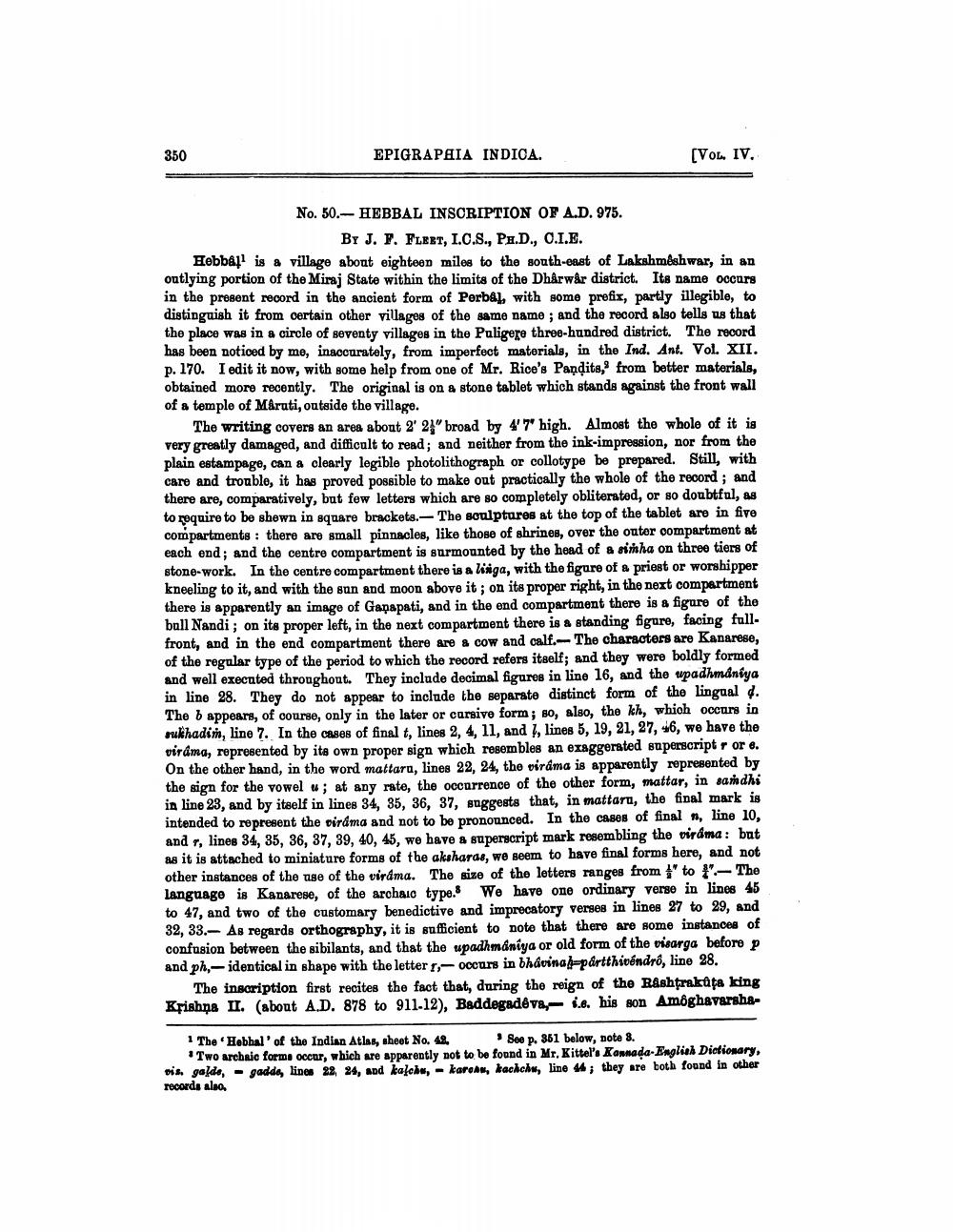________________
350
EPIGRAPAIA INDICA.
[VOL. IV.
No. 50.- HEBBAL INSCRIPTION OF A.D. 975.
BY J. F. FLERT, I.C.S., Ph.D., O.I.E. Hebball is a village about eighteen miles to the south-east of Lakshmeshwar, in an outlying portion of the Miraj State within the limits of the Dharwar district. Its name oocurs in the present record in the ancient form of Perbal, with some prefix, partly illegible, to distinguish it from certain other villages of the same name ; and the record also tells us that the place was in a circle of seventy villages in the Puligere three hundred district. The record has been noticed by mo, inaccurately, from imperfect materials, in the Ind. Ant. Vol. XII. p. 170. I edit it now, with some help from one of Mr. Rice's Pandits, from better materials, obtained more recently. The original is on a stone tablet which stands against the front wall of a temple of Maruti, outside the village.
The writing covers an area about 2' 21" broad by 4'7" high. Almost the whole of it is very greatly damaged, and difficult to read; and neither from the ink-impression, nor from the plain estampage, can a clearly logible photolithograph or collotype be prepared. Still, with care and trouble, it has proved possible to make out practically the whole of the record ; and there are, comparatively, but few letters which are so completely obliterated, or so doubtful, as to require to be shown in square brackets. The sculptures at the top of the tablet are in five compartments : there are small pinnacles, like those of shrines, over the outer compartment at each end; and the centre compartment is surmounted by the head of a sitha on three tiers of stone-work. In the centre compartment there is a liiga, with the figure of a priest or worshipper kneeling to it, and with the sun and moon above it ; on its proper right, in the next compartment there is apparently an image of Ganapati, and in the end compartment there is a figure of the ball Nandi; on its proper left, in the next compartment there is a standing figure, facing fullfront, and in the end compartment there are & cow and calf. The characters are Kanarese, of the regular type of the period to which the record refers itself; and they were boldly formed and well executed throughout. They include decimal figures in line 16, and the upadhmdniya in line 28. They do not appear to include the separate distinct form of the lingual 4. The b appears, of course, only in the later or carsive form; so, also, the kh, which occurs in sukhadin, line 7. In the cases of final t, lines 2, 4, 11, and !, lines 5, 19, 21, 27, 46, we have the viráma, represented by its own proper sign which resembles an exaggerated superscript r or e. On the other hand, in the word mattara, lines 22, 24, the piráma is apparently represented by the sign for the vowel w; at any rate, the occurrence of the other form, mattar, in sandhi in line 23, and by itself in lines 34, 35, 36, 37, snggests that, in mattara, the final mark is intended to represent the virama and not to be pronounced. In the cases of final # line 10, and , lines 34, 35, 36, 37, 39, 40, 45, we have a superscript mark resembling the virama: bat as it is attached to miniature forms of the akshards, we seem to have final forms here, and not other instances of the use of the viráma. The size of the letters ranges from 1 to - The language is Kanarese, of the archaic type. We have one ordinary verse in lines 45 to 47, and two of the customary benedictive and imprecatory verses in lines 27 to 29, and 32, 33.- As regards orthography, it is sufficient to note that there are some instances of confusion between the sibilants, and that the upadhmaniya or old form of the visarga before p and ph,-identical in shape with the letter r,- occurs in bhdvinah-partthivendro, line 28.
The inscription first recites the fact that, during the reign of the Rashtrakata king Krishna II. (about A.D. 878 to 911.12), Baddegadeve,- 1.6. his son Amoghavarsha
1 The Hebhal' of the Indian Atlas, sheet No. 42. See p. 361 below, note 8.
Two archaic forms occur, which are apparently not to be found in Mr. Kittel's Kannada-English Dictionary, ois golde, - gadde, lines 22, 24, and kalche, - karos, kachchu, line 44; they are both found in other records also




